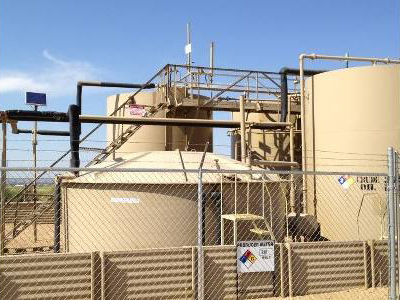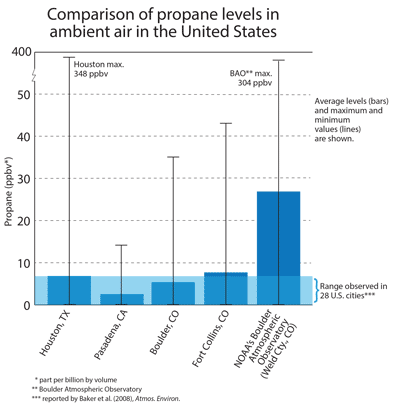2013 News & Events
Oil and Gas Wells Contribute Fuel for Ozone Pollution
14 January 2013
modified from the story by CIRES Communications

Emissions from oil and natural gas operations north of Denver could add to ozone pollution in that region, according to a new study by researchers from CSD and CIRES.
"At our test site in Weld County, we found that oil and natural gas operations are the dominant wintertime source of certain gasses, called volatile organic compounds (VOCs), that act as precursors – 'starting ingredients' – for ozone pollution," said research chemist and lead author Jessica Gilman.
Gilman's team found high levels of these VOCs, such as propane, in that area.
"Average levels of propane were higher than the range of values reported for 28 U.S. cities," Gilman said. "For example, they were four to nine times higher than in Houston, Texas, and Pasadena, California."
The researchers originally went to the test site, the Boulder Atmospheric Observatory tower about 2.5 miles east of downtown Erie, in winter 2011 to study nighttime air chemistry. "The high concentrations of several of the VOCs surprised us," Gilman said.
To discover the source of the VOCs, Gilman's team analyzed more than 550 air samples and determined that oil and natural gas activities were the primary source of those compounds and accounted for 55 percent of the hydrocarbons that contribute to ozone formation in this area.

At the time, Weld County had more than 15,000 active oil and gas wells; it currently has about 19,000. A component of raw natural gas, VOCs such as propane and ethane can leak during extraction, like bubbles escaping from a soda can. VOCs can then react in the air to form lung-damaging ozone pollution, a chief component of smog.
Since cars, vegetation, livestock, and other sources also emit VOCs, however, it wasn't initially clear how much of a role oil and gas wells played in the elevated VOC levels.
"When our first measurements came out, people would ask, 'How do you know the high level of pollutants is from natural gas? How do you know it's not from car exhaust, or cattle farms, or people's propane grills?'" Gilman said. "But we discovered that emissions from oil and natural gas activities have a unique 'chemical signature' that's very different from emissions from other sources, and it definitively identifies oil and gas wells as the major source of the high levels of VOCs like ethane and propane."
The researchers uncovered that signature by analyzing the chemical makeup of all the air samples—characterizing 53 different types of VOCs and comparing the results to the composition of raw natural gas.
"Each source has its own specific composition—cars look like one thing, trees like another, and so on," Gilman said. "Just like your nose knows what a flower smells like, or coffee, or a farm, our instruments can 'smell and identify' oil and natural gas emissions. The signature is a very clear, robust marker."
Once in the air, the VOC emissions can react with sunlight and nitrogen gases to form ground-level ozone pollution. Like wood fuels a campfire, Gilman said, VOCs can fuel the production of ozone pollution.
"What this study tells us is how much wood we have piled up there," she said. "So in the wintertime at the BAO tower site, oil and natural gas operations are the dominant source of ozone precursors."
The oil and gas footprint extends beyond Weld County, though. When the researchers took measurements near Fort Collins and in Boulder, north and west of the BAO tower respectively, they also detected emissions attributed to oil and natural gas there.
"Propane and ethane are fairly long-lived in the atmosphere, so they travel far," Gilman said. "No matter where you are in the Front Range, you can still see the signature of VOC emissions from oil and natural gas operations."
That's important since parts of northeastern Colorado marginally exceed EPA standards for ozone pollution.
The researchers next plan to monitor summertime oil and gas emissions, as well as emissions in other states with high oil and gas production, such as Utah.
The results are relevant for people beyond those areas though. "Sometimes people forget that we all live downwind of somebody," Gilman said.
Coauthors on the study include CSD and CIRES scientists Brian Lerner, William Kuster, and Joost de Gouw.
J.B. Gilman, B.M. Lerner, W.C. Kuster, and J. de Gouw, Source signature of volatile organic compounds (VOCs) from oil and natural gas operations in northeastern Colorado, Environmental Science and Technology, doi:10.1021/es304119a, 2013.
Abstract
An extensive set of volatile organic compounds (VOCs) was measured near Erie, Colorado in winter 2011 in order to investigate the composition and relative influence of VOC emissions from oil and natural gas (O&NG) operations in northeastern Colorado. Erie is located north of the Denver metropolitan area and is in the southwestern section of Wattenberg Field, one of Colorado’s most productive O&NG fields. We compare VOC concentrations in Erie to those in other U.S. cities, summertime measurements in Boulder and Fort Collins, Colorado as well as the composition of raw natural gas from Wattenberg Field. These comparisons show that (i) the VOC source signature associated with O&NG operations is distinctive and can be clearly differentiated from urban sources that are dominated by vehicular exhaust and (ii) VOCs emitted from O&NG operations are evident at all three measurement sites in northeastern Colorado. During the Erie study, the reactivity of VOCs with the hydroxyl radical (OH) was dominated by C2-C6 alkanes due to their remarkably large abundances. Through statistical regression analysis, we estimate that on average 58% of the VOC-OH reactivity was attributable to emissions from O&NG operations indicating that these emissions are a significant source of ozone precursors.